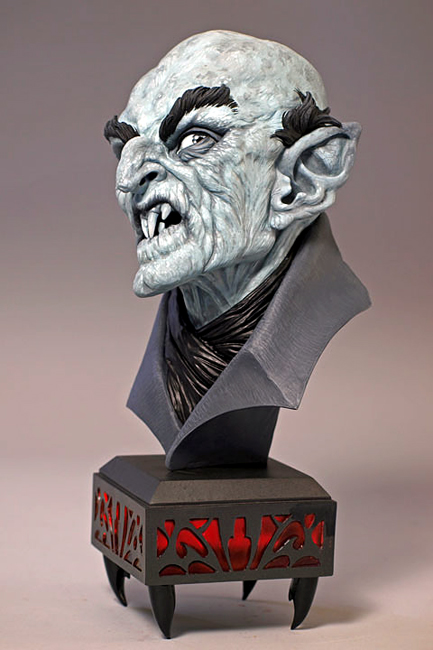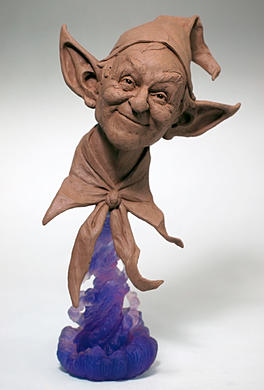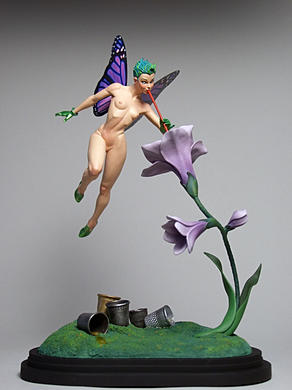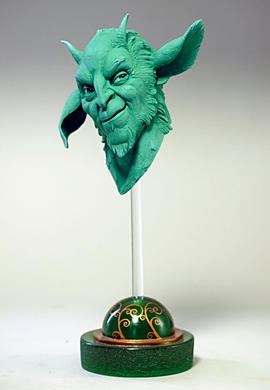Ahh, Tim Bruckner. He snuck up on me like a Seinfeld sideler, sending me an innocuous email a few years back saying he was a sculptor and was hoping I'd check out his work. I get a lot of emails like this, so of course I took a big swig of bad coffee and dug in for another 5 minutes of art perusing I knew would never get back, I clicked the link to his URL and...
...queue the angelic choir.
Uh, this wasn't a pimply 14 year old sending me off to his deviantart account full of misshapen ashtrays from ceramics class. This was THE Tim Bruckner, the guy that was so masterful a sculptor that his work "looks unreal, like a machine made it," as one of my visitors remarked. His work is seen on the set of The Big Bang Theory, it's in the Smithsonian, and most importantly, his work takes us back to a time when quality art in the public eye was about as American as, uh, pie. Humor, ruggedness, femininity, mystery, it's all there in a Bruckner piece, flawless, perfect.
 |
| Nosferatu |
So I was a little surprised, to say the least. From that email, the Masters of Sculpture show from 2013 was devised to expose Seattle to masterful work so very few of us get to see. Since then, we've taken Tim on board to represent as our newest Krab Jabber. As part of the rites of passage, I've asked Tim ten questions, and without further ado, this is Tim in his own words.
1. What brought you into sculpting? Were you always a sculptor?
I started sculpting when I was seven. I don’t know why. When I was a kid they had these wax tubes filled with a colored liquid so sweet you could go into insulin shock. One afternoon, after finishing a few tubes, I started sculpting the wax into the heads of a couple of the Seven Dwarves. I thought they were perfect. In hindsight, they probably looked more like somebody’s thumb than Grumpy or Doc. But something clicked that day. I persuaded my mom to take me to buy some clay. And they rest, as they say, is stuff that happened.
2. Do you have a sculptor you admire (both currently and in the past)? How have they inspired your work?
When I was growing up my sculpting heroes were a bunch of old dead guys: Michelangelo, Bernini, Cellini, St. Gaudens, Gilbert. Nobody in my family was into art. I didn’t know anyone who was. I stumbled upon pix of their work and didn’t get how they did what they did, but I did have a sense of why they did what they did. I was oddly attuned to compositional story telling. So, they inspired me to improve my technical skills to become a better story teller. Its something I’m still working on. As far as sculptors working today? There are some amazingly talented sculptors. It’s a long list. Many are, I’m lucky to say, my friends. They inspire me daily. First, there’s that little pinch of envy. And then, you feel the challenge. Its not competitive. Its creative curiosity. Why did they make the choices they made. How did they make it happen. And it gets you thinking about your own process, both from a design viewpoint and an execution viewpoint. And ain’t that what art is? Trying to translate the unknown.
3. What was your favorite piece of yours and why?
I have favorites for different reasons. Mostly, I like pieces that worked in spite of myself. Pieces where I was smart enough to get out of my own way and let the piece decide where it wanted to go. That’s not an easy thing to do. With any artist who appreciates the power of technique, its hard to not play into it. When you know what it is you want to say, it’s important to not oversell it with an artistic sleight of hand. Currently, I like, Belle et la Bete, SHE, He Who Laughs Last, ONE, Something to Consider, Eve Decides and IMAGINE. In a couple of months, the list will change.
 |
| Imagine, showing it illuminated from the inside |
4. How do you start your sculptures? Do you do drawings first?
With personal work, I very, very rarely do any prep work. As a hands-for-hire sculptor for over forty-six years, working from 2D feels a lot like a job. I have an armature, some clay and some free time. And whatever happens, happens. Like I said earlier, the trick is not to get in the way. But with a piece like I am the Walrus, its such a complex piece, with so many elements, I needed a guide or sorts. And even with the design, I’m discovering things I could not have anticipated in its execution. But Walrus in an exception.
 |
| I Am the Walrus, work in progress |
5. Has your industry changed a lot since you started? How so? Is it easier/harder?
The industry is significantly different. I’d been a professional for twenty years before I got my first sculpting credit. That meant I had the opportunity to get better. I got to learn. I got to learn how to be a better sculptor and learn what it meant to be a professional.
Both of those opportunities are almost not available. These days, good, bad or adequate, you get credit. And it follows you. That’s not always a good thing. And there’s almost no place where you get to learn what it is to be a professional. How to understand what the job is and do the job.
When I started, you either made your own molds, cast your own resins, produced your own paint masters, or you passed it off to someone else, to accommodate some else’s schedule. If I have a three week deadline and I have to budget my time getting my stuff to a mold maker, a caster and a painter, I’ve lost a week, at least, and a week I could be sculpting. The more time with the piece, the chances are you get a better piece. When you do it all yourself, you have total control. Client likes your work, it all on you. If they don’t, the same. You deliver what you mean to deliver, not what someone else thinks you mean. And, all the service costs go into your pocket. But most importantly, when you know each step, all the way to finish, and you understand what you can and can’t do, you are much more likely to produce work that pushes the boundaries of what is possible.
And that makes you a better designer and a better engineer.
The biggest change, of course, is digital modeling. Almost every major gift, toy or collectible company relies more and more on digital modeling. From their perspective, it’s more efficient. And maybe in some instances, it is. But it’s shifted the production of product from a collaboration between the sculptor and their AD, to solely the discretion and direction of the product manager. And a good many PM’s, have almost no actual 3D experience. And, from my perceptive, the best 3D work is created by someone who knows what works in real space, under real lighting conditions, in a real environment.
 |
| Something to Consider |
There is no substitute for creating a physical reality in a physical reality.
Easier/harder? Depends on who you are, where you are in your career and what you want out of it.
6. If there was one thing you could tell your younger self, what would it be?
Anything I would have told myself wouldn’t or couldn’t apply. You took every job you could. Ever sculpt a one legged pirate kitten? You bet! I’m looking for someone to sculpt a set a chimpanzee Siamese twins. Interesting, I did that this morning. By the time I hit my thirties I’d sculpted perfume bottles, puppet heads, a life size alligator suit, action figures, comic heroes, I’d done album covers, editorial illustration, written, recorded and produced three children’s albums, produced limited edition bronzes and had worked for virtually every major gift, collectible and toy company in America. And none of that could happen today. I guess, if I could tell my younger self anything it would be, take a moment to pull your head out of your ass and have a look at the bigger picture. But when I came up, there was no bigger picture. You were lucky to connect the dots.
 |
| Afternoon Delight |
7. So many folks don't seem to know how to display or live with sculpture. Do you have thoughts on that?
Displaying sculpture is different than hanging something on the wall. With something 2D, you find a place, drive in a nail, hang the sucker, and there it is. And the longer it is where it is, the less you see it. It becomes like a lamp or a wall clock. Rarely do lighting conditions affect it. But with something 3D, it has to occupy a different physical space. Its on a table, or a shelf, a mantle or in a display case. The changes of light during the day, and night lighting alters its character. Even the shadow it casts can change our perception of it. But just like something 2D, we stop really seeing it after a time. It becomes part of our décor. I strongly urge people to move their 3D stuff around. Move it off the shelf in the den into the bedroom or the kitchen. Take it out of the display unit and put it on top of the TV cabinet or the mantle and see how changing its place in your day to day, changes your relationship to it. A sculpture seen in morning light will change character at dusk.
 |
| DC Wonder Woman, based on a Brian Bolland design |
8. What is the next step in your career? You are semi-retired, so you must be up to something!
One of the things that being off deadline has given me is the ability is to think things through. When I was pulling a full free-lance schedule, I like most free lancers, sandwiched personal work in between deadlines. You got done what you had time to get done. Its not that you didn’t have time to think about it, you just didn’t have time to change your mind. Now that I have the time, I’m surprised at how my work has been able to evolve. The first piece I experienced that with was SHE. I started off thinking one thing, and the more I thought about it, the more it evolved and, I think, for the better.
Same with Eve Decides, most certainly with I am the Walrus. I think that’s the biggest difference, the chance to change my mind to make something better.
9. Do you have a favorite hobby outside of your work?
I write. I’ve always written. I became a little more serious about it when I started writing Christmas stories. When our kids were young, I’d write a Christmas story with them in it and read it to them over the Holidays. As they got older, and were less inclined to listen to their old man drone on, I started expanding. Over the past twenty or so years I’ve written Christmas themed stories that have run the gambit from hardboiled detective to Renaissance mystery. Then I got kind of more serious. I had my first book of fiction, Sensible Redhorn, published by Pro Se in 2013. And my second, The Adventure of the Pearl le Fong, published last year. I have another ready to go this year with Pro Se and several ready to be published through Airship 27. I enjoy the hell out of writing. And the same thing holds true with writing as it does for sculpture, my job is to just stay out of the way. I’m just here to take notes. Oh, and I like feeding the birds. And they like me doing it.
10. Is there any advice you would give to an artist interested in sculpting?
Focus. There is so much more competition these days. You might be a multi-dimensional talent but Art Directors are looking for someone to do a specific job. When you show your portfolio and it’s got everything from super heroes to baby gorillas, its difficult for them to see what it is you do. So, starting off, pick something you like doing and are good at doing. Once you start getting work you can reveal more of who you are. Starting out, variety confuses people. Your AD and your audience are more comfortable putting you in a box. Once they know and understand you and your work, the box can get bigger and can have other boxes inside it.
There are so many different ways to apply your talent, don’t get stuck thinking your future is in doing action figures or art dolls. Be open to any opportunity that presents itself. You never know where things might lead. A variety of professional experiences can only make you better.
Learn the business of art. It’s a business and you need to know how it works.
Hit your deadline. If you don’t there’s someone just as good as you are who will. Don’t take front money until you’ve done something for it. I’ve known too many artists who have taken front money for a bunch of jobs only to be squeezed by due dates and nothing to show for it. When you get screwed, and you will, move on. Learn how it happened and why it happened and don’t’ let it happen again.
Most of all, be kind and supportive. And be generous. When you give freely and openly of your time and experience its makes for better artists and better art. And isn’t that something we all want?
 |
| A Little Mischief |
___
Tim's work is featured regularly on his own Krab Jab page, as well as one of the featured artists in our May 2015 show, entitled Lennon, opening May 9th (Tim will be there!).
No comments:
Post a Comment